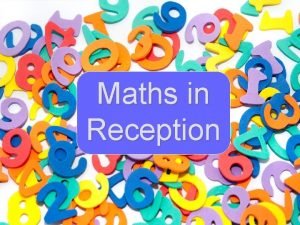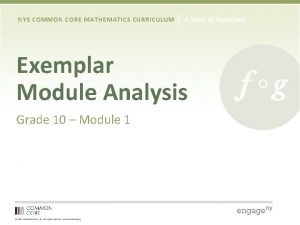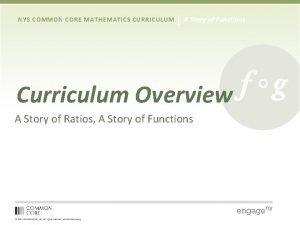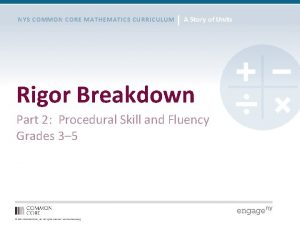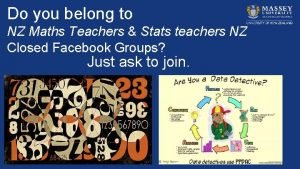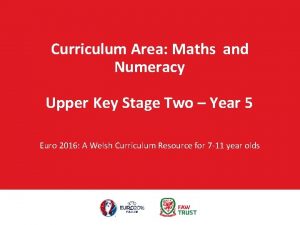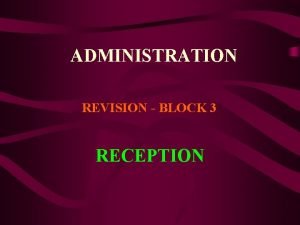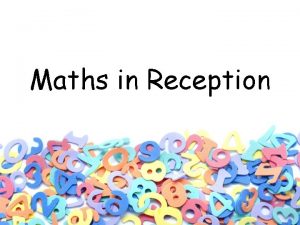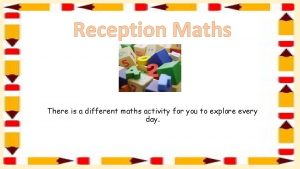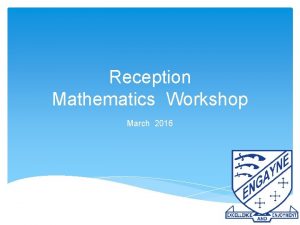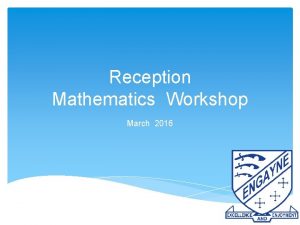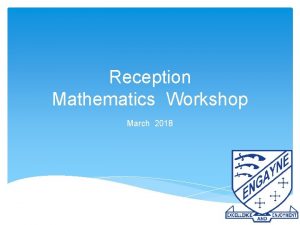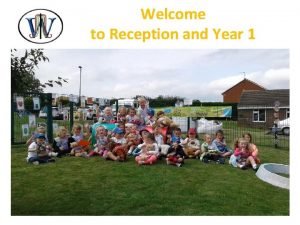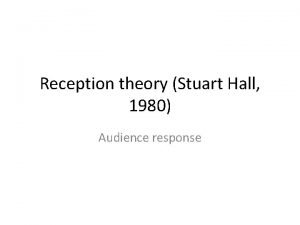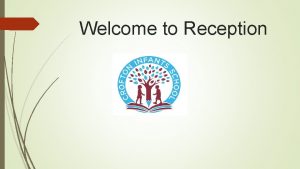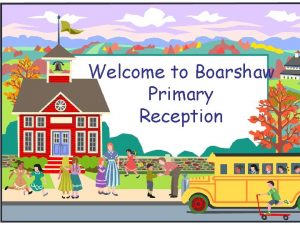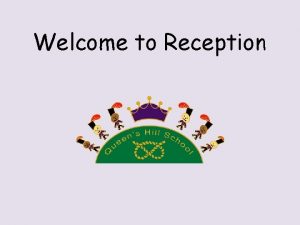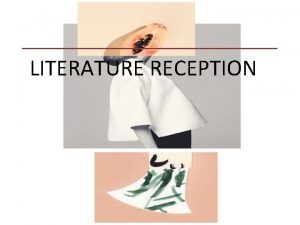Maths in Reception The Maths Curriculum Mathematics is


















- Slides: 18

Maths in Reception

The Maths Curriculum Mathematics is split into 2 further sections; • Number • Shape, Space and Measures

The Maths Curriculum ELG 11 - Number Children count reliably with numbers from 1 to 20, place them in order and say which number is one more or one less than a given number. Using quantities and objects, they add and subtract two single-digit numbers and count on or back to find the answer. They solve problems, including doubling, halving and sharing.

But what does this mean? • • • • Count forwards and backwards in 1 s Count objects by saying one number name for each item Recognise numerals Order numerals Begin to count in 2 s and 10 s Select the correct numeral to represent a number objects Can find 1 more or 1 less than a number Know that the number of objects stays the same no matter how they are arranged Estimate how many objects they can see and check by counting them Find the total number of items in two groups by counting all of them Find doubles of numbers Find half of a number Share objects between people Solve problems using doubling, sharing, halving, adding, subtracting

The Maths Curriculum ELG 12 – Shape, Space and Measures Children use everyday language to talk about size, weight, capacity, position, distance, time and money to compare quantities and objects and to solve problems. They recognise, create and describe patterns. They explore characteristics of everyday objects and shapes and use mathematical language to describe them.

What does this mean? • • • Use mathematical names for ‘solid’ 3 D shapes and ‘flat’ 2 D shapes Use mathematical terms to describe shapes – flat, curved, edges, corners Describe position – behind, next to, in front, on top, underneath Order two or three items by length or height Order two items by weight or capacity Use familiar objects and common shapes to create patterns and build models Use everyday language related to time Begin to use everyday language related to money Order and sequence familiar events Measure short periods of time in simple ways

How is it taught? • Practically • With purpose • Through exploration

Small World Put the seal at the top of the slide What is next to the tree? We need 7 people over by the water

Role Play Can you set the table with 4 plates, 4 cups, 4 bowls? If one more person came, how many would we need? Labels Numbers displayed Shapes Maths talk

Outside Provision

What do we use? • Number lines • Hundred squares • Counting objects • Numicon

Number Fluency

Numbers beyond 20 Point out large numbers in the environment -seat numbers -door numbers -bus routes -raffle tickets -prices in shops -ages -calculators

What can you do at home?

Number Walk up the stairs counting – to make this harder you could count in 10 s, 2 s or start on different numbers Pair up socks, gloves or shoes and count in 2’s Look at the numbers on the front doors of a street, what is missing? Can you spot the pattern? Ask questions – how many more/less, if I added 2 on what would I get?

Shape Look at different shapes in the environment and describe them Make 2 D shapes from lolly pop sticks. Can they make the shapes using their bodies? Shape hunt t h g i a r t What s u o y n a c shapes see? It’s got 3 edges. What shape is it?

Measures • Which flower is the shortest/tallest? • Can you make a snake which is longer/shorter than this one? • Which bag do you think will hold the most/least? Why? • Baking is a great way for children to begin to understand weight

Problem Solving Try to make it part of everyday life I’ve got 3 carrots, I need 3 more. How many will I have altogether? I had 4 flowers yesterday and now I’ve got 6. How many more flowers have I got now? If we have 10 sweets and we share them out between 2 people, how many sweets will we both have? If we have 5 pencils, how many different ways can we put them into 2 pots?
 Reception maths curriculum
Reception maths curriculum Nys common core mathematics
Nys common core mathematics Whats common
Whats common Nys common core mathematics curriculum
Nys common core mathematics curriculum Nzmaths rich tasks
Nzmaths rich tasks Upper key stage 2 maths
Upper key stage 2 maths Bổ thể
Bổ thể Diễn thế sinh thái là
Diễn thế sinh thái là Vẽ hình chiếu vuông góc của vật thể sau
Vẽ hình chiếu vuông góc của vật thể sau Phép trừ bù
Phép trừ bù Chúa yêu trần thế alleluia
Chúa yêu trần thế alleluia Lời thề hippocrates
Lời thề hippocrates đại từ thay thế
đại từ thay thế Quá trình desamine hóa có thể tạo ra
Quá trình desamine hóa có thể tạo ra Cong thức tính động năng
Cong thức tính động năng Thế nào là mạng điện lắp đặt kiểu nổi
Thế nào là mạng điện lắp đặt kiểu nổi Khi nào hổ mẹ dạy hổ con săn mồi
Khi nào hổ mẹ dạy hổ con săn mồi Tỉ lệ cơ thể trẻ em
Tỉ lệ cơ thể trẻ em Dạng đột biến một nhiễm là
Dạng đột biến một nhiễm là
